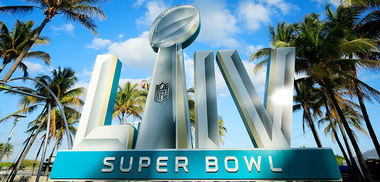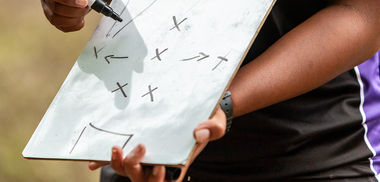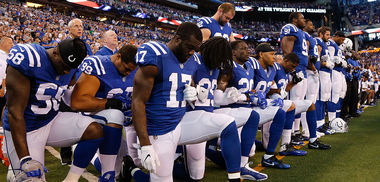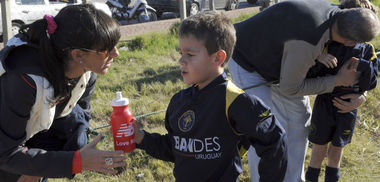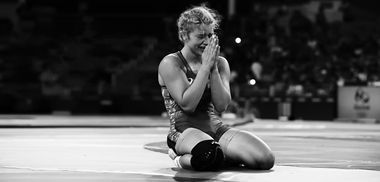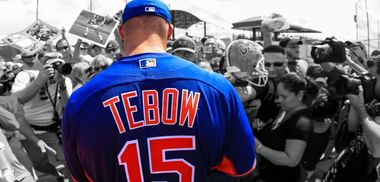Last week’s MLB Opening Day brought many things with it...the pageantry, the spring air, the hopes of a new champion, the challenge of defending a title. And often most anticipated of all, the questions surrounding the many roster moves each offseason, perhaps especially this year with several record-breaking contracts being signed.
All the roster changes remind me of one great roster in particular that seems to resurface this time of year. I’m talking about the St. Louis Wolves of the 1940s in the famous Abbott & Costello “Who’s On First” comedy skit. If you’re in need of a good laugh, look for it on YouTube now. The skit depicts the friend of a baseball manager asking about the players on his team. He wants to know their names so he can say hello to them personally. He begins by asking who is playing first base. The problem is that the name of the first baseman is Who. Thus, when he asks the manager, “Who is on first?”, the manager hears it as a statement, not a question. What ensues is a classic case of miscommunication as the names of the rest of the players are similarly exceptional. While the scene poses many more statements than questions, the question of the identity at a certain position is one worth considering.
Suppose the roster were full of players named “Who.” They might all look like they get along and are pretty unified. They have a lot in common, after all, and unity is highly valued when discussing chemistry on championship teams.
However, things would get confusing pretty quickly and undoubtedly fall apart. To make it less fictional, although not necessarily more realistic, imagine if an entire baseball team were filled with only first basemen. Or if a basketball team were filled with only point guards. Or if a crew team were filled with only coxswains. Or if a gymnastics team were filled with only those considered experts in the vault. None of these teams would be very good at all. In fact, I bet each would be the worst team among their competition, even if comprised of the best individuals at each of those skill sets. Why?
"I want relatable sports ministry tools!"
It is because diversity is not only necessary, but invaluable in achieving success. When coupled with unity, diversity is a powerful force.
Diversity of skill is what makes a team a team. If everyone plays the same position on the court, that’s not a team. That’s a tryout. The end goal is to find the most-skilled individual possible at each and every unique position on the field (diversity) and put them on that field at the same time to work together (unity) in order to attain victory.
But both diversity and unity involve hard work. It’s important for us to understand what diversity and unity are and what they are not.
1. Diversity is a God-given reality, but not automatic.
Here’s no new headline: people are different! In any and every way possible, we are vastly different from each other, and that’s God’s own design. From things built into our DNA (such as skin color, personality traits, brain processes, eye color, propensities and giftings) to things that are often more learned or developed (such as sports fandom, cultural norms, tastes for food, passions and values), God has made no two people alike (even twins!). I have often heard people point to diversity and culture as a curse after the construction of the Tower of Babel in Genesis 11, when He confused their language and dispersed the people. Yet diversity was around long before that. Time doesn’t allow for a discussion here on the research behind the origin of various skin tones, but simply looking at etymology (the meanings of names), which were often used as descriptive terms in ancient times, reveals great diversity among races. To read further on this, consider Dwight McKissic’s excellent book Beyond Roots: In Search of Blacks in the Bible.
The problem is, the old adage “birds of a feather flock together” is true. Diversity is not automatic. It’s easier to stay in a group of people who look, sound, dress and think like me. The early spread of people groups and nations in Genesis confirms this, as if we needed any evidence. The danger in staying in any kind of monocultural world is that I think that everyone looks, sounds, dresses, and thinks like me! Or at the very least, as I recognize those around me who are different, I conclude they are the enemy.
Recently, I heard what has become invaluable insight and a great reminder to me: My normal is not everyone else’s normal. And neither is yours. A classic example of this is holiday traditions. My wife often refers to her first Thanksgiving in college when she discussed with her roommates what was eaten at their family dinners. “What?! You don’t have __ for Thanksgiving?” It didn’t take much to realize that her normal tradition was not the same as everyone else’s. If we can remember this throughout all of life, we’re headed in the right direction.
2. Diversity is to be celebrated, not ignored, feared or changed.
As we begin to understand the different “normal” that every individual has, we can begin to celebrate those things. Another problem though, specifically when it comes to race, is that often, the conversation ventures down this dead end: “I don’t see color. I’m colorblind.”
This is honestly just a copout way to ignore the hard work it takes to get to know others who are different than us. Or we allow mass misconceptions or the exceptional news headline to create fear in us, which moves us away from relationship and into isolation. However, as I’ve slowed down to consider people different than me, various cultures have become treasures.
In the West, we have been taught to value bigger, better, and faster. Thus, advancements in technology are looked at with wonder and worked for with near-desperate zeal. But who’s to define and declare that it’s any “better” than a civilization without such technological infrastructure. The simple ways of living in many “third-world” countries are actually deeply profound and beautiful when looked at with a celebratory perspective.
3. Diversity is complementary, not incompatible.
First Corinthians 12 includes a lengthy discussion by the Apostle Paul on how a church family ought to function together. These principles can apply to any entity.
[14] For the body does not consist of one member but of many….[16] And if the ear should say, “Because I am not an eye, I do not belong to the body,” that would not make it any less a part of the body. [17] If the whole body were an eye, where would be the sense of hearing? If the whole body were an ear, where would be the sense of smell? [18] But as it is, God arranged the members in the body, each one of them, as he chose…. [21] The eye cannot say to the hand, “I have no need of you,” nor again the head to the feet, “I have no need of you.”...[25] that there may be no division in the body, but that the members may have the same care for one another. [26] If one member suffers, all suffer together; if one member is honored, all rejoice together.
We can see here how the individual parts of our bodies are each valuable and have a role to play. If our whole body were an eye, not only would it be creepy, but how would we hear? If everyone on the team is a Who, who can Who throw the ball to but another Who?
The parallel to any sports team or business, and to God’s family is that diversity is supposed to move us forward, if we can work together! Incompatibility is not much more than an unwillingness to figure out how to work together. An eye and an ear complement each other to make watching a sports competition an incredible experience. How much more beautiful are two people who are vastly different sharing their life experiences with one another!
Not only is it beautiful, but it’s necessary. If we are going to become all of who God wants us to be, we need each other. God crafted each of us in His image. That means that someone who is different than me holds a different piece of God’s image. So, if I want to get to know more of who God is, I must get to know more of His creation, most notably, people different than me.
That brings us to unity.
1. Unity is togetherness, not sameness.
Romans 12:4-5 says, “For as in one body we have many members, and the members do not all have the same function, so we, though many, are one body in Christ, and individually members one of another.” In the same way that diversity doesn’t equal incompatibility, unity doesn’t equal sameness. Like the absurd examples above of a team with only players of the same position, so in life if there is nothing but sameness and uniformity, a family, a team, a business, even society as a whole cannot function successfully. Yet we often think that we must have virtually everything common to work together well. Sure, it takes more work if there are more differences, but there is indeed greater beauty. The more different two individuals are, the more areas in which sacrificial love, trust, and unity can be displayed.
2. Unity is sacrifice, not agreement.
Unity indeed involves laying down one’s preferences. But it doesn’t mean agreement in every area or even the most deeply held values. Again, this isn’t about sameness. It isn’t about seeing eye-to-eye. It is about seeing another person as a human being created in God’s image who has every right to their deeply-held values, as different from mine as they may be. We often think that different equals wrong or bad. But that is simply not true. I can choose to sacrifice my way of doing things without condoning someone else’s way.
Unity chooses to listen first. Unity chooses to listen with the intent to understand rather than with the intent to respond. It chooses empathy before correction or advice. But it does not ignore the truth nor condone destructive behavior. It actually loves so much that, within a deeply connected relationship, it points out danger, including self-inflicted threats from poor choices.
3. Unity is God’s goal, not a popular trend.
God has always known that unity is best displayed among diversity. He Himself is a diverse God, existing in three distinct persons. Yet He is more intimately unified than we can describe. And He desires the same for us, those made in His image.
One day, that will be finally and fully accomplished. Revelation 7:9-10 gives a glimpse into the future:
“After this I looked, and behold, a great multitude that no one could number, from every nation, from all tribes and peoples and languages, standing before the throne and before the Lamb, clothed in white robes, with palm branches in their hands, and crying out with a loud voice, ‘Salvation belongs to our God who sits on the throne, and to the Lamb!’”
In Heaven, those who have trusted Jesus to pay for their sins will be together in unity worshipping Him while retaining their diversity! This is an amazing image! Our culture, ethnicity, even languages, are part of the redeemed and restored eternal world. This is another reason why we cannot ignore these parts of who we are and who others are. They won’t be ignored for all eternity. How dare we attempt to be “colorblind” or devalue someone else’s “normal.” For years upon years upon years those pieces of us, those pieces of God’s image, will be kept and celebrated!
This is written in a book 2000 years old. It is not a popular trend by social activists. It is sewn into the fabric of the universe that God created and planned into the future He is moving all of history towards. We don’t need Abbott and Costello to show us how futile a lack of diversity is. We don’t need an athletic team to show the amazing things that unity can accomplish. God Himself shows us the beauty of unity amidst diversity. Jesus commands us to pray for His will in Heaven to be done on earth, which includes the multi-ethnic worship of Him.
At the end of the day, it is indeed up to the manager or coach of a team to put his or her players where they will most flourish for the sake of the team, whether their names are Who, What or I Don’t Know (see the skit!). God is our Coach and wants to position His team in the way He sees fit. It’s time we submitted to that and moved towards one another to celebrate, complement, be together, sacrifice, and achieve God’s goal.


